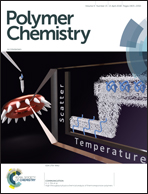High-throughput physicochemical analysis of thermoresponsive polymers†
Abstract
Calculating the lower critical solution temperature (LCST) of a thermoresponsive polymer is an important measure of its physical properties. Here, the LCST of poly(N-isopropylacrylamide) (pNIPAM) was determined by measuring the scattered light intensity in a real-time thermocycler. This method allowed for the investigation of low concentration (μg mL−1) samples in low volumes (μL). Subsequently, the critical micelle temperatures (CMTs) and concentrations (CMCs) were simultaneously recorded in 2 h for over 220 samples of the thermoresponsive copolymers of NIPAM with N-hydroxymethyl acrylamide (HMAM) (pNIPAM-co-HMAM (2.5–12.5 mol% HMAM)). This high-throughput approach paves the way to rapidly ‘map’ the physicochemical properties of low abundance polymers with statistical accuracy.



 Please wait while we load your content...
Please wait while we load your content...